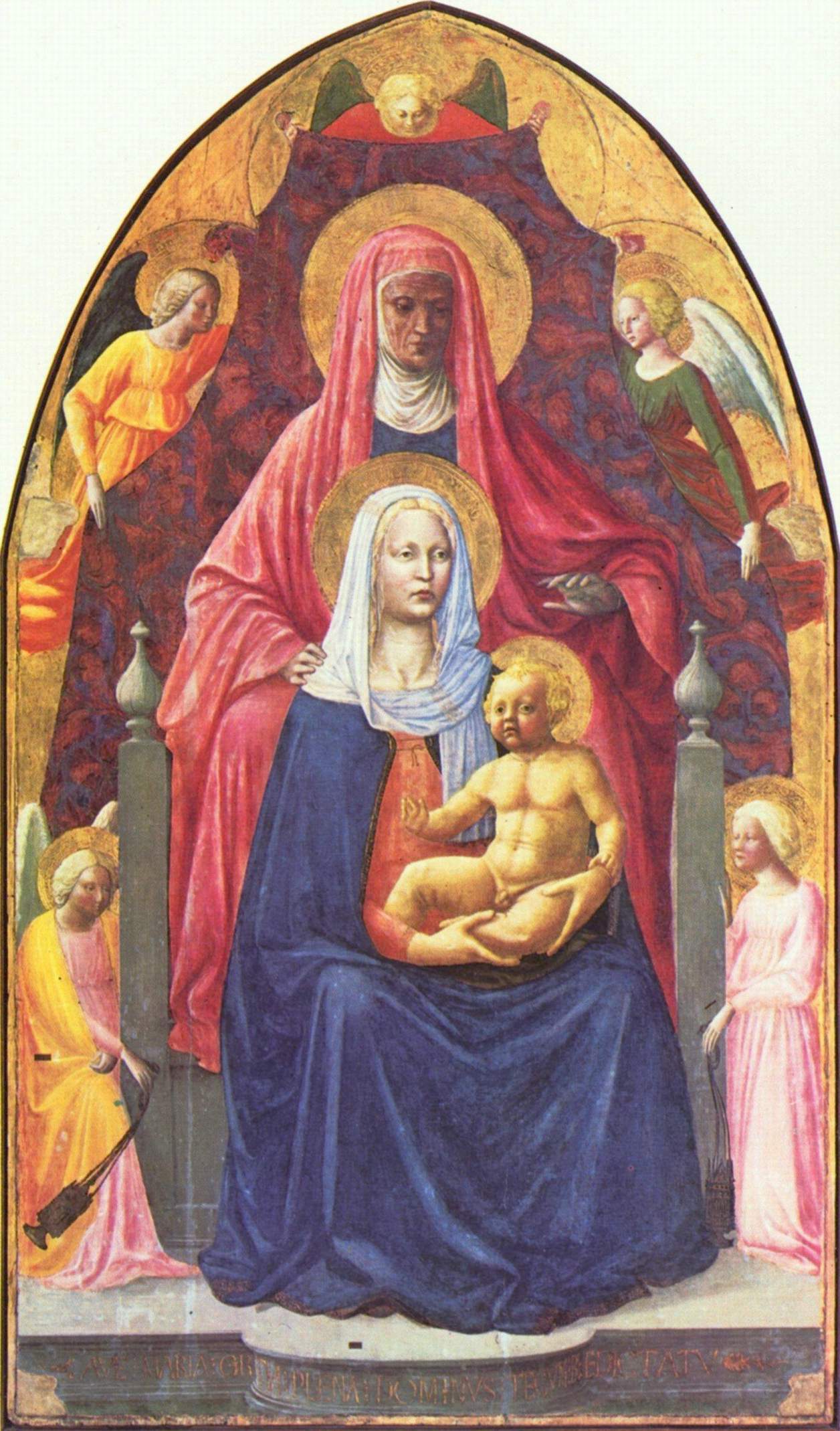Virgin and Child with St. Anne (Masaccio)
- Virgin and Child with St. Anne (Masaccio)
Infobox Painting|

title=Madonna and Child with St. Anne
artist=Masaccio and Masolino da Panicale
year=c. 1424-1425
type=Tempera on panel
height=175
width=103
museum=UffiziThe "Madonna and Child with St. Anne", also known as "Sant'Anna Metterza", is a painting by the Italian Renaissance painter Masaccio, probably in collaboration with Masolino da Panicale, c. 1424.
The Virgin and Child, with its powerful volume and solid possession of space by means of an assured perspectival structure, is one of the earliest works credited to Masaccio. But for one, the angels, very delicate in their tender forms and pale, gentle colouring, are from the more Gothic brush of Masolino; the angel in the upper righthand curve reveals the hand of Masaccio. The figure of St. Anne is much worn and hence to be judged with difficulty, but her hand, which seems to explore the depth of the picture-space, may well be an invention of Masaccio. The ‘Madonna and Child with Saint Anne’ was originally commissioned for the Sant’Ambrogio church in Florence. According to Vasari, “It was placed in the chapel door which leads to the nuns’ parlour”.
The figure of Christ is that of a young child, a realistic presence, rather than a gothic cherub. This is also one of the first paintings to display the effect of true natural light on the figure; it is this invention which imparts the modelling of form so characteristic of Masaccio, and which would have a profound influence on the painting of the Italian Renaissance.
Wikimedia Foundation.
2010.
Look at other dictionaries:
Masaccio — Detail of St. Peter Raising the Son of Theophilus and St. Peter Enthroned as First Bishop of Antioch, Brancacci Chapel, S. Maria del Carmine, Florence Birth name Tommaso di Ser Giovanni di Mone (Simone) Cassai … Wikipedia
Masaccio — (Tommaso di Ser Giovanni di Mone; 1401 c. 1428) Masaccio was born in San Giovanni Valdarno, near Florence where he is recorded as having joined the painters guild in 1422. Masaccio was his nickname, a derogatory appellation that referred to… … Dictionary of Renaissance art
painting, Western — ▪ art Introduction history of Western painting from its beginnings in prehistoric times to the present. Painting, the execution of forms and shapes on a surface by means of pigment (but see also drawing for discussion of depictions in … Universalium
Leonardo da Vinci — Da Vinci redirects here. For other uses, see Da Vinci (disambiguation). Leonardo da Vinci Self portrait … Wikipedia
Masolino — orig. Tommaso di Cristoforo Fini born 1383, Panicale, Romagna died probably 1440–47, Florence, Republic of Florence Italian painter. He came from the same district in Tuscany as his younger contemporary Masaccio, with whom his career is closely… … Universalium
Western sculpture — ▪ art Introduction three dimensional artistic forms produced in what is now Europe and later in non European areas dominated by European culture (such as North America) from the Metal Ages (Europe, history of) to the present. Like… … Universalium
1420s in art — The decade of the 1420s in art involved some significant events.EventsFebruary 19, 1426: Masaccio was commissioned to paint a major altarpiece, the Pisa Polyptych alterpiece in the church of Santa Maria del Carmine in PisaWorksPainting* 1420:… … Wikipedia
Collection of the National Gallery, London — Rembrandt, Belshazzar s Feast (1635) … Wikipedia
List of Roman Catholic Church artists — This list of Catholic artists concerns artists known largely or primarily for works of Roman Catholic religious art, a subset of Christian art in general. It may also include artists whose position as a Roman Catholic priest or missionary was… … Wikipedia
100 Great Paintings — was a television series created by Edwin Mullins for BBC 2 in 1980, in which he also acted as moderator.http://ftvdb.bfi.org.uk/sift/series/11652 13 January 2007] He chose 20 thematic groups, such as war, the Adoration, the language of color, the … Wikipedia

